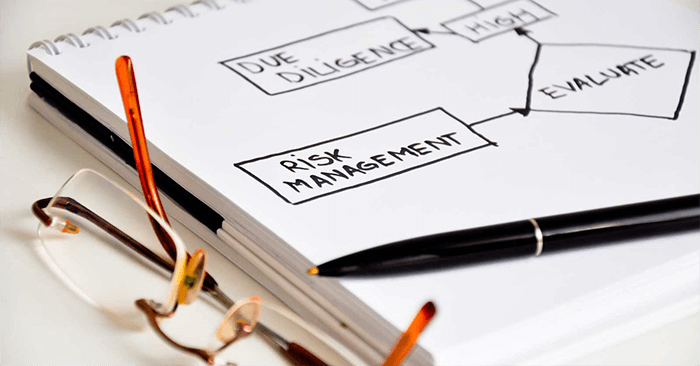Hello everybody! I am Lal Hmachhuani who is working as a Web Developer in SpiceworksMyanmar Co.Ltd. Today, I would like to share about Risk Management. When we do projects, we usually face many difficulties because of risks. I hope that this ten golden risk rules give you guidelines and can help how to implement risk management successfully in your project. I wish you success with your projects.
Risk management is an ongoing process to identify potential problems that could arise when new projects occur within a business. This allows to deliver the project on time, on budget and with the quality results that the project sponsor demands. Also, team members will be much happier if they do not enter a fire fighting mode needed to repair the failures that could have been prevented.
Rule 1: Make Risk Management Part of Your Project

The first rule is essential to the success of project risk management. If you don’t truly embed risk management in your project, you cannot reap the full benefits of this approach. You can encounter a number of faulty approaches in companies. Professional companies make risk management part of their day to day operations and include it in project meetings and the training of staff.
Rule 2: Identify Risks Early in Your Project
Two main sources exist to identify risks, people and paper. People are your team members that each brings along their personal experiences and expertise. Interviews and team sessions (risk brainstorming) are the common methods to discover the risks people know. Paper is a different story. Projects tend to generate a significant number of documents that contain project risks.
If you combine a number of different identification methods, you will have enough time left for the unexpected risks that take place.
Rule 3: Communicate About Risks
A good approach is to consistently include risk communication in the tasks you carry out. If you have a team meeting, make project risks part of the default agenda (and not the final item on the list!) This shows risks are important to the project manager and gives team members a natural moment to discuss them and report new ones.
Another important line of communication is that of the project manager and project sponsor or principal. Focus your communication efforts on the big risks here and make sure you don’t surprise the boss or the customer! Also, take care that the sponsor makes decisions on the top risks because usually some of them exceed the mandate of the project manager.
Rule 4: Consider Both Threats and Opportunities
Project risks have a negative connotation: they are the bad guys that can harm your project. However, modern risk approaches also focus on positive risks, the project opportunities. These are the uncertain events that are beneficial to your project and organization. These good guys make your project faster, better and more profitable.
Unfortunately, a lot of project teams struggle to cross the finish line, being overloaded with work that needs to be done quickly. This creates a project dynamic where only negative risks matter (if the team considers any risks at all). Make sure you create some time to deal with the opportunities in your project, even if it is only half an hour. The chances are that you will see a couple of opportunities with a high payoff that doesn’t require a big investment of time or resources.
Rule 5: Clarify Ownership Issues
Assign a risk owner for each risk that you have found. The risk owner is the person in your team that has the responsibility to optimize this risk for the project. The effects are really positive. At first, people usually feel uncomfortable that they are actually responsible for certain risks, but as time passes they will act and carry out tasks to decrease threats and enhance opportunities.
The ownership issue is equally important to project opportunities. Fights over (unexpected) revenues can become a long-term pastime of management.
Rule 6: Prioritize Risks
Some risks have a higher impact than others. Therefore, you better spend your time on the risks that can cause the biggest losses and gains. Prioritization measure you use, use it consistently and focus on the big risks.
Rule 7: Analyze Risks
Risk analysis occurs at different levels. If you want to understand a risk at an individual level, it is most fruitful to think about the effects that it has and the causes that can make it happen. Looking at the effects, you can describe what effects take place immediately after a risk occurs and what effects happen as a result of the primary effects or because time elapses. A more detailed analysis may show the order of magnitude effect in a certain effect category like costs, lead time or product quality.
The information you gather in a risk analysis will provide valuable insights into your project and the necessary input to find effective responses to optimize the risks.
Rule 8: Plan and Implement Risk Responses

Implementing a risk response is the activity that actually adds value to your project. You prevent a threat occurring or minimize negative effects. Execution is key here.
If you deal with threats, you have three options, risk avoidance, risk minimization and risk acceptance. Avoiding risks means you organize your project in such a way that you don’t encounter a risk anymore.
The biggest category of responses are the ones to minimize risks. You can try to prevent a risk occurring by influencing the causes or decreasing the negative effects that could result.
A final response is to accept a risk. This is a good choice if the effects on the project are minimal or the possibilities to influence it prove to be very difficult, time-consuming or relatively expensive. Just make sure that it is a conscious choice to accept a particular risk.
Rule 9: Register Project Risks
This rule is about bookkeeping .Maintaining a risk log enables you to view progress and make sure that you won’t forget a risk or two. It is also a perfect communication tool that informs your team members and stakeholders what is going on.
A good risk log contains risk descriptions, clarifies ownership issues and enables you to carry out some basic analyses with regard to causes and effects. If you record project risks and the effective responses you have implemented, you create a track record that no one can deny. Even if a risk happens that derails the project. Doing projects is taking risks.
Rule 10: Track Risks and Associated Tasks
Tracking tasks is a day-to-day job for each project manager. Integrating risk tasks into that daily routine is the easiest solution. Risk tasks may be carried out to identify or analyze risks or to generate, select and implement responses.
Tracking risks differs from tracking tasks. It focuses on the current situation of risks. Which risks are more likely to happen? Has the relative importance of risks changed? Answering these questions will help to pay attention to the risks that matter most for your project value.
In Summary
The ten golden risk rules above give you guidelines on how to implement risk management successfully in your project.
I wish you success with your project!



